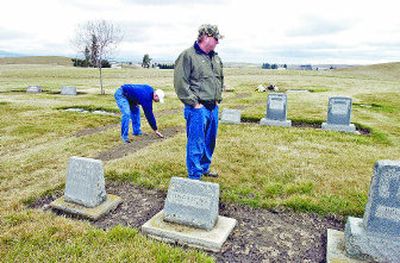Mount Hope cemetery holds more than past

Last Thursday, as Steve Primmer walked through Mount Hope Cemetery, the air smelled as if the spring rains had finally scrubbed away the winter residue. His boot heels sank a good inch into the saturated soil, which couldn’t push the green grass up fast enough to compete with the low-slung clouds overhead.
Spring at the cemetery is all about gently bringing the ground out of its winter stupor. There are headstones in need of righting after being knocked this way and that by buckling frosts and soil-softening thaws. There are wheel ruts to be filled in where a backhoe left the ground unapologetically crushed.
It matters that things be taken care of at the first break of spring because this is where the stories of the tiny Palouse community of Mount Hope come to an end. The nearly 600 people buried here outnumber Mount Hope’s living population roughly tenfold. The farm community 34 minutes due south of Spokane Valley is so small it bids its visitors welcome and adieu with a simple, two-sided sign. Its most recognizable feature is the tiny white chapel on the cemetery’s northern edge. The way to Mount Hope, which trails west off State Route 27 less than 100 yards past Rockford, is aptly named Valley Chapel Road.
Primmer, who lives near that sign, has taken care of this cemetery for the better part of two decades. It is, he said, the pride of the community, and most people not only recognize the names on the headstones here, they know many of the stories behind them.
“There used to be a lot more people living there,” Primmer said, “but they moved over here.”
The cemetery was created by local pioneer George Cornwall after his wife, Phebe, died in 1882. The lichen-crusted dates carved into her white marble headstone indicate Phebe wasn’t quite 32 when she died. Originally, she was buried beside the Cornwall family cabin, Primmer said, but she was relocated after George Cornwall donated the first piece of land for the community burial ground.
Measles did her in. We know this because old Palouse farm families record their time on the rolling plain like hourglasses count sand; nothing goes by unnoted.
Primmer draws his information from a hardbound book on the community that was written by a relative, Ardis Deshiell. The last entry of every story always ends here, and the information is drawn from the private Genesis of individual Mount Hope families. Most families have a book, or books, full of begats and departures, homes pinpointed along townships and ranges. Sections bought then split into halves, quarters and finally acres with the addition of each new generation. Farm families document every road traveled and every trail long plowed under.
They record the rapid undoing of a family of six, reduced to three by diphtheria. They mark the arrival of every child and the death of every young mother in labor.
“Times were just harder then,” said Shirley Seehorn, whose husband, Lloyd, was born in a farmhouse not too far from the cemetery.
There’s a marker at Mount Hope for Lloyd’s mother, Lula, who died at age 42, two months after giving birth to her seventh child. Lloyd keeps an aged, black-and-white photo of that funeral, in which six farmwomen pallbearers carry Lula’s casket to a freshly cut hole in the Mount Hope sod.
It wasn’t Lloyd’s last trip to the cemetery to bury a young mother. A couple of years after his mother’s death, Lloyd’s father, Roy, remarried and tried having children again. Nora Seehorn died giving birth to Roy’s last son.
Married for more than 50 years, the Seehorns have already put a stone down at Mount Hope, which is where Lloyd’s family lies along with a half-sister of Shirley’s. The granite marker bears both their names along with an etching of a motorcycle that Lloyd’s pretty certain would have been left off had the arrangements been left to his kids.
“Lloyd loved his motorcycles,” said Primmer, who, walking among the tombstones, doesn’t break out of the past tense in referring to the yet-to-buried Seehorns.
Here, the future is the past.